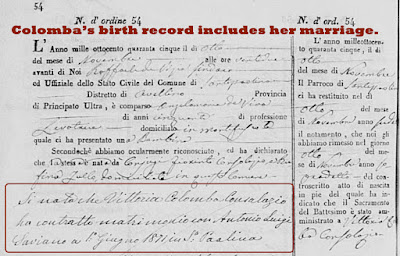I'm transcribing an enormous collection of vital records for my genealogy research. Here's why I'm not nuts for doing so.
If your ancestors came from a small town, there was most likely a ton of intermarriage going on. And it's very possible that families stayed in one town for hundreds of years. Some may have moved to the next town to marry.
Because my roots are almost entirely in 5 little towns there, I've begun an ambitious project.
 |
| This massive project will connect me to thousands of relatives. |
I discovered a software app that let me download massive collections of birth, marriage, and death records from my towns to my computer. (See "How to Use the Online Italian Genealogy Archives".)
Here's how I've been using these document images so far.
First, I located the vital records for my closest ancestors: my grandfathers, all my great grandparents, and their parents. I put these images in my family tree software.
Next, I began searching for other babies born to my ancestors. I put their facts and documents images in Family Tree Maker, too.
Then, I started sifting through one town's birth records, pulling out all the babies with a particular last name. This is an exercise that I hope will lead me to a missing link. I need to find the one married couple who are the reason why my parents share DNA. (See "The Leeds Method May Have Solved a Big Family Puzzle".)
The thing is, I know there are countless relationships to me waiting to be discovered. That's why I want to put each image's facts into a searchable, sortable spreadsheet. Each time I discover a relative, I put that image in my tree and color the spreadsheet line green. That lets me know I've already found that relationship.
Yesterday I completed one chunk of this project. It was a reasonable amount of work—not overwhelming. That feeling of accomplishment has me excited to do more. It was one of my 2019 Genealogy Goals: to enter the first 5 years' worth of births from each town into my spreadsheet. (See "How to Set Realistic Genealogy Goals for 2019".)
After typing the names, dates, and places from 1,000s of documents into an Excel file, I realized 3 powerful benefits to this seemingly insane project.
1. Name Recognition
 |
| What do you mean, you can't read this? |
- which family names are common in the town
- which given names are commonly found together (Nicola Domenico, Maria Antonia, Francesco Saverio)
- what the street names were (and maybe still are) in this town
With repetition, even if the quality of the document or the handwriting are awful, you'll recognize names in a heartbeat.
2. Spotting Familiar "Faces" As You Type
Excel has an AutoComplete feature that's proving very helpful. As I enter several years' worth of birth records, couples are going to show up, having another baby every couple of years. Thanks to AutoComplete, as I begin typing the father or mother's name, I can see that I've entered their name before.
Sometimes I may be unsure of a name. There's could be a blotch on the page, or ink may be bleeding through from the other side. But as I start typing, the name I'm about to type appears in AutoComplete. That's a confirmation that I was making the right choice.
3. Lightning-Fast Searches
I saved the best for last.
Normally, to find a particular person, I have to look at the files for each year. I go to each year's index and try to find the name I need.
But with all the facts—names, dates, ages, occupations, addresses—in a spreadsheet, searches are faster than any genealogy site's search function. No online connection needed.
Imagine being able to find, in one search, each document where your great grandfather is:
- the baby
- the groom
- the father of the baby
- the decedent
My spreadsheet inventory of all my ancestral towns will be the single greatest genealogy database for ME. What can you build for your family tree research?























